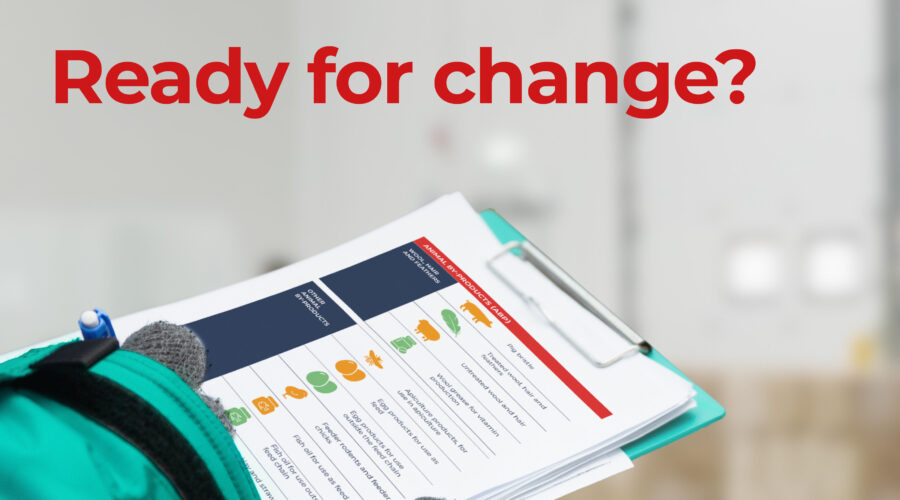
TOM risk categories for POAO – are you ready?
There’s just four months to go until new inbound checks come into effect for products of animal origin (POAO) and foodstuffs coming into the UK from the EU.
Is your business ready to cope with these changes?
While October 31 may seem a long time away, the reality is when it comes to transport logistics, the sooner you can prepare yourself for these changes, the easier your life will be.
As European transport logistics experts, we know how complicated imports and exports can be.
The upcoming risk-based regime for animals and animal product commodities requires businesses to locate the Target Operating Model (TOM) risk category for each product you’re importing.
Once you’ve located your risk category (low, medium, high), you will be expected to follow the sanitary and phytosanitary (SPS) rules for that import risk category.
Each category is based upon a scientific assessment of any biosecurity and food safety risk. The assessment will be weighed against the impact of the disease and the pest risk of the country of origin.
The purpose of the new categorisations is to seamlessly create a fluid response to changing risk levels throughout the EU. If required, a risk category can be upgraded, or downgraded according to changing levels of risk.
Is your business ready for these changes?
Our role is to work with businesses like you to help prepare for these changes. We want to help you proactively assess your import processes, so you are not caught out once they come into effect from October.
We are advocating for businesses to start focusing on the new regulations now, so there is plenty of time to cope with any teething problems or changes to your import processes before the new legislation comes into effect.
If you need help to review your processes, or you’re not sure how this could affect your imports, please phone us.
We’ll be happy to chat through all the details and help you prepare for 31 October.
How to find the TOM risk category for animals and animal products
The UK government has already outlined the different Target Operating Model (TOM) risk categories.
Here is a brief summary of how different types of animals and animal products will be categorised.
However, you should review the official government guidance to make sure you are acquainted with any specific notes or terms and conditions of each category.
Are there any specific rules for each risk category?
Along with knowing what category your goods fall under, it’s essential you acquaint yourself with the correct paperwork and documentation for each category. Even if your goods fall into the low-risk category, you should be aware of the rules for medium and high-risk categories because your category could change with minimal notice.
Failing to have the right documentation in place could cause lengthy delays in your imports, as well as running the risk of heavy fines.
Part of our transport logistics support is to help businesses like you make sure you have the right paperwork in place to manage your imports.
If you have any questions about the specific rules, and how these could affect your import processes, please give us a call.
We’re always happy to chat through these changes and explain what you need to do to prepare.
The Low TOM risk category
- If your goods are classed as low risk, you will need to notify authorities before their arrival through the import of products, animals, food and feed system (IPAFFS).
- You do not need a health certificate, but Low TOM risk category consignments must come with a commercial document from the supplier.
- It’s important to note some animal by-products currently need a facilitation letter to import from the EU. From 31 October 2023 you’ll no longer need a facilitation letter for these products if they are in the Low TOM risk category.
The Medium TOM risk category
- You must use the IPAFFS to notify authorities before any items arrive in Great Britain.
- From 31 October 2023 each consignment must have a health certificate issued by the competent authority in the country where the goods originate.
- Beyond this, from 31 January 2024 the Medium TOM risk category may be subject to physical import checks.
The High TOM risk category
- As with the low and medium categories, you must use IPAFFS to notify authorities before any goods arrive in Great Britain.
- Like the medium-risk category, the consignment must have a health certificate issued by the competent authority in the country where the goods originate.
- Most consignments in the High TOM risk category are already subject to physical import checks. These checks will continue in the same way after 31 October 2023.
Medium or High TOM risk categories, but no health certificate
- If a health certificate does not exist for the goods you want to import from the EU, you may need an import licence or authorisation.
- You will need to contact the Animal and Plant Health Agency (APHA) Animal Imports team if:
- There’s no licence for your animal or germinal product.
- You’re not sure if you need a licence.
- If you are importing a medium-risk animal by products, but there’s currently no health certificate for your goods, you will require a commercial document.
Are these changes only applicable to EU imports?
At the moment, these changes are only eligible for EU imports as of the 31 October 2023.
The purpose of these changes is to ensure SPS controls are being applied consistently. Therefore, all imports from any EU country will be subject to these rules. Similarly, EFTA countries (Norway, Switzerland, Iceland and Lichtenstein) will also be included within the new commodity code search tool.
Further guidance TOM risk categories for imports of animals and animal products from non-EU countries will be released imminently.
As soon as we’re aware of the details, we’ll be able to update you further.
Waller Transport Services specialise in European transport logistics
If you’re looking for a logistics provider to help you import goods into the UK, you’ve come to the right place. Our network of hauliers across mainland Europe means we have the systems and processes in place to get your goods from A-B.
Our European freight services go beyond just the transportation. We work with you to identify and streamline any paperwork and documentation, ensuring your imports arrive on time and on budget.
To find out how we can help you, please get in touch.
